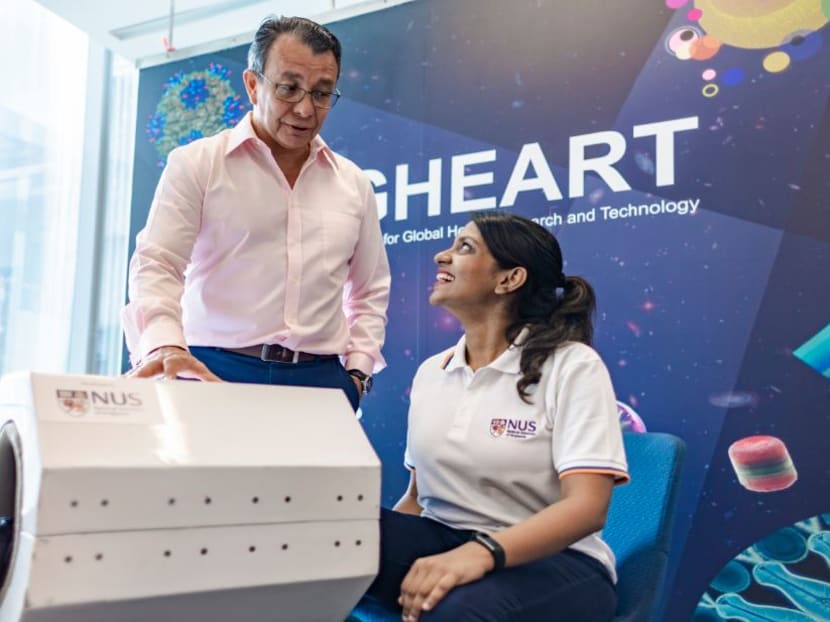New medical device uses magnetic field to boost muscle recovery
SINGAPORE — Patients who have undergone anterior cruciate ligament (ACL) surgery — a common type of knee operation — typically take about 16 weeks to heal, but researchers here have developed a medical device that can shave a month off the recovery period.

NUS Associate Professor Alfredo Franco-Obergón (left) leading a demonstration of MRegen. He led a team of researchers in developing the medical device that uses magnetic field to regenerate muscle cells.
SINGAPORE — Patients who have undergone anterior cruciate ligament (ACL) surgery — a common type of knee operation — typically take about 16 weeks to heal, but researchers here have developed a medical device that can shave a month off the recovery period.
The device, developed by researchers from the National University of Singapore (NUS), harnesses magnetic field to speed up muscle recovery. The procedure is non-invasive and painless, and the creators say it could benefit post-surgical patients, the elderly and professional athletes.
Named MRegen, the magnetic stimulation “tricks” muscle cells into thinking that they are exercising. The cells are then activated and regenerate at a faster speed.
The device provides a magnetic field that, at an optimised magnitude and pulse duration, reproduces the same regenerative, energetic and metabolic responses as physical activity. It is roughly 10 times the strength of Earth’s natural magnetic field.
Associate Professor Alfredo Franco-Obergón said that at 10 minutes for each use, the settings of the procedure have been “optimised to provide the largest therapeutic effect in terms of muscle quality, function and metabolic stability.”
“The device is especially useful in reducing muscle degradation in periods where physical activity is not possible,” added Prof Franco-Obergón, who leads the team at NUS’ Biomedical Institute for Global Health Research and Technology. He is from the Department of Surgery at the Yong Loo Lin School of Medicine.
The device prototype has a hollow column for the user to insert his leg and rest it there for the treatment duration of 10 minutes.
CLINICAL TRIALS SHOWED PROMISING RESULTS
Two clinical trials which were held from 2015 to 2017 produced promising results.
In the first trial, 10 healthy individuals received the magnetic treatment once a week for five consecutive weeks. They showed an average of 30 to 40 per cent improvement in muscle strength, in both legs.
The second trial involved 20 patients who had undergone ACL knee surgeries. Half of them were given the normal rehabilitation therapy, while the remaining received MRegen treatment in addition to the normal therapy.
Those that only underwent normal rehab recovered in 16 weeks, while those who underwent MRegen treatment in addition to the normal rehab recovered in 12 weeks.
Additionally, Magnetic Resonance Imaging (MRI) measurements showed that their muscle metabolism improved by 50 per cent. Muscle metabolism is one of the strongest indicators of muscle health and regeneration.
IMPACTS THE WHOLE BODY, NOT JUST ONE AREA
Prof Franco-Obergón called the device a “breakthrough”, as both trials observed that treatment in one leg also improved the health of the other leg, and ultimately the whole body.
The magnetic field stimulates mitochondria, which are the “powerhouses” of a cell that work to generate energy. In turn, myokines are produced. These are molecules that yield positive effects elsewhere in the body.
“One of the very profound and surprising efforts, was that the myokine effect is stronger than we ever realised. Just stimulating one leg secretes myokines that get transported to the whole system,” Prof Franco-Obergón said.
The secretion of myokines reduces blood pressure and glucose levels in the whole body, he added.
“We go for the leg because there’s more muscle. The more muscle you implicate, the better,” he said.
FUTURE PLANS
The NUS research team filed a patent for the technology in May last year, and has also since spun off a company, QuantumTX, to commercialise it.
Prof Franco-Obergón identified three potential applications for the device. Firstly as proven by the second trial, MRegen can help post-surgical patients to reduce muscle degeneration and shorten rehabilitation durations.
Secondly, the device can help slow muscle loss and maintain healthy muscles in the elderly.
Lastly, it can help maintain muscle mass for professional athletes, especially during their off-season.
In the long run, the professor is also eyeing the possibility of using the device in cancer treatment.
“Myokines have strong anti-cancer properties, and we are definitely looking towards that area,” Prof Franco-Obergón said.
Meanwhile, the research team is planning one more clinical trial, before putting their technology on the market.
Translation specialist and QuantumTX CEO Ivan Goh said the team aims to have the first machine set up in eldercare facilities by 2020, in line with efforts to cater to Singapore’s ageing population.
“This might come in the form of a gym machine of sorts, to target frailty,” Mr Goh said.
The team then plans to launch medical devices for post-surgery and recovery applications by 2021.
“Medical devices take a bit longer because of the need to go through validation trials, and regulatory hurdles,” he added.









